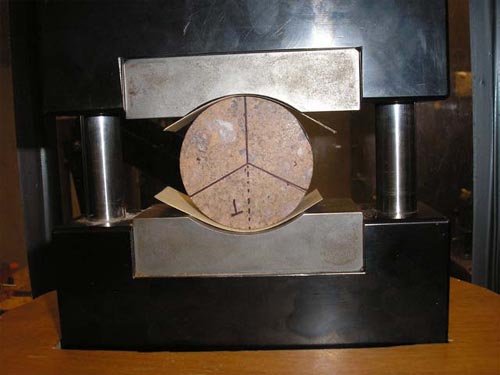Concept
Brazilian Test is a geotechnical laboratory test for indirect measurement of tensile strength of rocks. Due to its simplicity and efficiencly, it is amonst the most commonly used laboratoory tesing methods in geotechnical investigation in rocks. The test is sometimes is used also for concrete
Description and Procedure
In the Brazilian test, a disc shape specimen of the rock is loaded by two opposing normal strip loads at the disc periphery. The specimen diameter shall preferably be not less than NX core size (54 mm), or at least 10 times the average grain size. The thickness/diameter ratio should be 0.5 to 0.6.The load is continuously increased at a constant rate until failure of the sample occurs within few minutes. The loading rate depending on the material and may from 10 to 50 kN/min. At the failure, the tensile strength of the rock is calculated as follows.
s_t=2P/(pDL)
P - applied load
D - diameter of the sample (D=2R)
L - thickness of the sample
The above equation uses the theory of elasticity for isotropic continious media and gives the tensile stress perpendicular to the loaded diameter at the center of the disc at the time of failure. If the sample is anisotropic and exhibits weakness planes (preferred orientation of minerals or stress history), the specimens should be prepared in such a way that both directions parallel as well as perpendicular to such planes can be tested (axis of the cylinder parallel to the plane)

Standards
- ASTM Standard Test Method D3967-81 Link
- International Society for Rock Mechanics Suggested Methods "Rock Characterisation, Testing and Monitoring" Editor E.T. Brown, Pergamon Press 1981, pages 119 to 121.
References - External Links
- Principles and procedure of Brazilian test, University of Colorado, CVEN 5768, lecture Notes 8, B. Amadei
